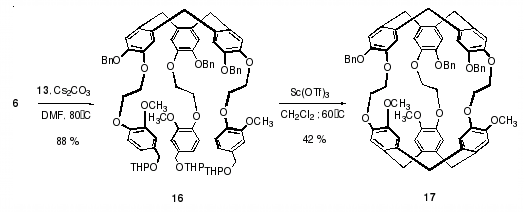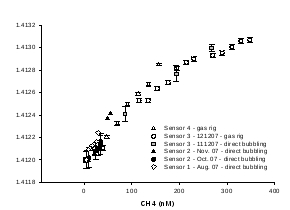Cryptophanes: Chemistry and complexation properties.
Synthesis of cryptophanes.One of our main objectives is to maintain a high level in one of the fundamental of chemistry that is organic synthesis. Considering the synthesis of cyclotriveratrylenes (CTV) and cryptophane hosts, a new method has been related recently (J. Org. Chem., 2005) and concerns the use of scandium triflate [Sc(OTf)3] for the preparation of molecules that could not be synthesized or easily obtained by using the known experimental procedures. With catalytic amounts of scandium triflate, CTVs were obtained with yields similar or higher than those reported previously. Cryptophanes were also synthesized in fairly good yields by performing the ring closure step in presence of a stoichiometric amount of Sc(OTf)3. Interestingly, this novel approach strongly reduces the formation of side-products and gives rise to novel functionalized molecules for the construction of supramolecular host-guest systems. |
 |
 |
Cryptophanes and sustainable chemistry: Detection of methane.Cryptophanes are known for their extraordinary complexation properties towards small neutral or charged molecules. For example, methane can be recognized by cryptophane-A. Because of its importance in environmental chemistry, its detection, storage and transformation are presently very active research topics. In collaboration with the Ecole Centrale (EC) in Lyon, an evanescent fiber sensor for a specific detection of methane was fabricated by the inclusion of cryptophane molecules in a transparent polymeric cladding (polysiloxane), on a PCS fibre. With Cryptophane-A, for alkane concentrations less than 8%, sensitivity for methane is six times higher than for other alkanes (ethane and butane) (Sens. Actuators B, 2005). Further, with the same group at the EC Lyon, an innovative optical fiber sensor associated to near-infrared detector was adapted to follow in situ ageing of transformer oil and the formation of methane (and other gas) that can cause explosion (Sens. Actuators A, 2008). Recently, a new method for in-situ detection and measurement of dissolved methane in seawater with a limit of detection of 0.2nM has been elaborated in collaboration with the National Oceanography Centre in Southampton (Optics Express, 2008). The detection method is based on refractive index (RI) modulation of a modified PolyDiMethylSiloxane (PDMS) layer incorporating molecules of cryptophane-A. Surface plasmon resonance (SPR) was used to measure the RI. |



